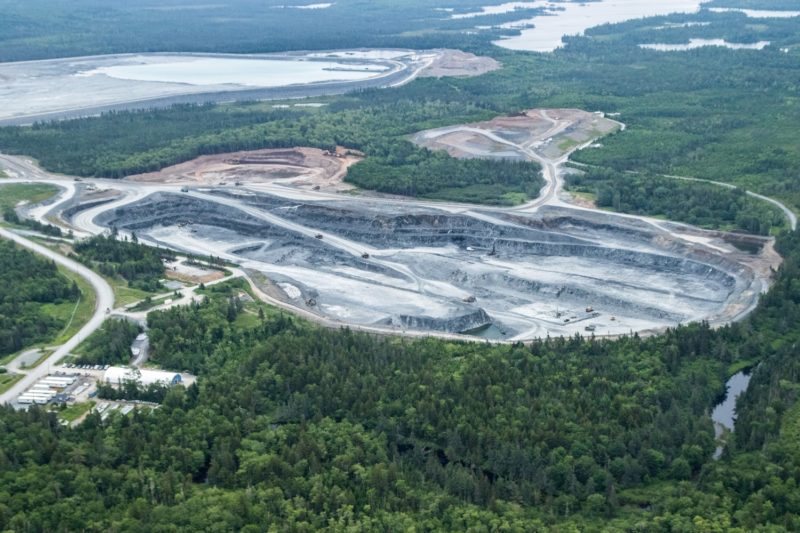Nova Scotia is home to a growing population, an increasingly diverse culture, boasts some of the world’s best beaches and lobster, and to support all of this, a rich resource economy.
Operating inland in Nova Scotia for over 15 years, Atlantic Gold was acquired by St Barbara Ltd in 2019. The Australian based company was founded in 1969 and is a gold producer and explorer. Through its acquisition, the company made an investment worth $722 million in Canada and in the province’s mining industry.
“We believe that Nova Scotia has great promise as a viable, attractive place to do business both in the country and in North America,” says Craig Jetson, St Barbara CEO. “We are a growing gold company with a global outlook. Every day we live by our company commitments to safety, empowering people and diverse teams, building stronger communities, respecting the environment and growing sustainably.”
Two of St Barbara’s commitments are respecting the environment and growing sustainably. “We take those commitments very seriously and our staff makes every effort to effectively manage our operations to ensure we have as little impact on our surrounding environment as possible,” says Jetson. “In the rare instance that we do have an impact, we work with regulators and the community to ensure any impacts are addressed and remediated.”
The mining industry is at a very interesting point in the world, in the country and in the Province of Nova Scotia. “It is clear that our industry needs to make a greater effort to reduce our overall carbon footprint and play a part in lower CO2 emissions,” says Jetson. “For St Barbara’s part, we have made a company-wide commitment to being carbon neutral by 2050, however, our Atlantic Operations will lead the way with a much earlier target.”
Gold mining as an industry creates heated discussions from those concerned about the surrounding environment. “I appreciate those who have questions and concerns that can be addressed and answered by studying impacts and providing qualified scientific data,” says Jetson.
“The Province of Nova Scotia and Canada must grow and develop. Resource extraction, completed with the greatest respect for protecting the environment, will play a role in successfully developing Nova Scotia’s rural economy.”

Building stronger communities is another commitment of St Barbara’s, and the team lives by it every day—more so after the impacts of the COVID-19 pandemic became clearer. “We focus our work in the communities around our current and proposed operations in three areas: poverty prevention, improving the health of local residents, especially seniors, and bettering educational outcomes of the youngest members of our communities,” says Jetson.
Prior to St Barbara’s acquisition of Atlantic Gold, the company’s focus was already in these areas, but it has taken those efforts a step further.
“Our company has kept positive relationships with groups focused on reducing poverty and providing access to items required to do so,” says Jetson. “We have supported local food banks and other community groups supporting low- income families.”
Moreover, the company has made major donations to local hospitals and seniors’ homes. In the beginning of the COVID-19 pandemic, the Nova Scotia team reached out to senior homes in the communities, where they operate, and asked how they can help. The result is the fostering of strong and enduring relationships that will last for many years to come.
“The industry, St Barbara included, must do more to recognize and acknowledge the role of First Nations communities in the stewardship of the land in the province and around our operations,” says Jetson.
Creating closer relationships with Canada’s First Nations based on respect, transparency and mutual benefit should be a priority for all businesses that rely on the country’s natural resources, such as St Barbara.
“Our company also has made a commitment to supporting youth and graduates in the communities where we operate to achieve their dreams,” says Jetson. “Having the opportunity and ability to achieve one’s goals is important to youth and young adults in Nova Scotia.”
St Barbara is part of providing that opportunity, no matter where the graduates of today plan to explore tomorrow. The company has worked with local schools and school- related groups to provide bursaries and supports to students looking to make their future in Nova Scotia and beyond.
Providing many lucrative benefits, Nova Scotia’s mining industry’s main economic contributions are provided directly by St Barbara. “For example, at our current mine in Moose River, Nova Scotia, we employ over 300 local residents and our annual payroll tops over $25 million,” says Jetson. The company generates millions of dollars in spending that flows into the local and Canadian marketplace to buy goods and services to support mining operations.
For the more-difficult-to-quantify indirect benefits, St Barbara was able to put them into perspective. The staff, travelling roundtrips every day for their jobs, create economic growth and, most importantly, economic opportunity. “We really look for partners including local residents, business associations and non-government groups to support those who see a future for themselves in the economic activity created by our mining operations,” says Jetson.
“Existing businesses in the Musquodoboit area will gladly tell you of the added revenue generation and employment created by our operations. The Eastern Shore of Nova Scotia is an area that needs growth and opportunity, and St Barbara wants to be one of the companies that creates the conditions for the area to succeed.”

Aside from existing operations at Moose River, St Barbara has three more gold mine projects in various stages of the federal and provincial government permitting process: Beaver Dam, Fifteen Mile Stream and Cochrane Hill. The federal and provincial permitting process is a stringent one based in science. “We are working within that process to create the best mine site that we possibly can,” says Jetson.
“From my time working both globally and locally within Nova Scotia, the province must decide what role the mining industry plays in creating opportunity and prosperity in the rural areas of the province.”
The team at St Barbara believes in a stringent and consistent regulatory regime for mining in the province. It needs provincial government decisions to provide consistent regulatory environment for companies to grow and create additional opportunity.
“We want to provide opportunity while meeting or exceeding every regulation of the provincial and federal governments,” says Jetson. “There is an opportunity for the Province of Nova Scotia, the communities around our operations and St Barbara employees to grow and prosper together.”
Heading oceanside, Canada has the longest coastline in the world, spanning over 240 thousand kilometres. With that comes an ocean territory of 7.1 million kilometres, making up 70 per cent of Canada’s landmass. Nationally, the Canadian ocean economy employs over 300,000 people, contributes 31 billion dollars to the economy annually, and it’s expected to yield a five-to-one return on investment in sustainable ocean economy for the next 30 years.
One of four Ocean Supercluster Projects is a group of allies who are accessing, engaging and supporting a diverse ocean economy. Amongst them is the Centre for Ocean Ventures and Entrepreneurship (COVE). The centre was instrumental in the proposal and establishment of the supercluster.
“The world is investing in and has recognized the value of the ocean economy,” says Melanie Nadeau, Chief Executive Officer of COVE. “It is the largest ecosystem on earth, the main food source for half of the world’s population, and over three billion people rely on the ocean for their livelihoods.”
“The annual economic value of the sustainable ocean- based economy, also known as the blue economy, is about CAD $3 trillion, equivalent to the world’s 7th largest economy.”
Since its inception in 2016, COVE has created the globally relevant ocean innovation cluster to drive ocean technology commercialization from right here in Halifax. Ocean technology ranges from the growth of start-ups and scale- ups into resilient small and medium-sized businesses, to talent development and specific programming to accelerate the commercialization of new products and services.
The provincial world-class ocean innovation ecosystem is growing at a globally unique pace with COVE as its industrial growth hub. The ocean tech sector alone generates over $1 billion to the provincial economy. Hence why COVE is central to many facets of the ecosystem such as the Ocean Frontiers Institute (OFI), Creative Destruction Lab, Bedford Institute of Oceanography, the Canadian Navy and the National Shipbuilding Strategy.
“We are building a high-value, high-tech industry based on our ocean advantage and ability to innovate,” says Nadeau. “We must keep pace, as there’s a global recognition of the value of the sector and the blue economy, in particular.”
COVE is anchored by the national shipbuilding strategy: An $80 billion dollar investment over the next 25 years. It’s a tremendous opportunity to create a growth sector in Nova Scotia and the Atlantic region. With such growth, there is capacity to create opportunities for talent to remain in the region, while attracting people from all over the world to work and live in Halifax.
“Bringing together people, ideas, industry and research, COVE enables our community and members to work in new ways by creating the world’s next practical, commercial, sustainable and revolutionary ocean tech advances across five sectors,” says Nadeau.

The sectors form part of the ocean economy including defence and security, fisheries and aquaculture, marine tourism, offshore energy and marine transportation. “Across these sectors, we focus on applied innovation by connecting talent, physical and natural assets, and programming to sustainably use ocean resources for inclusive economic growth, improved livelihoods and jobs while preserving the health of the ocean ecosystem,” says Nadeau.
Enabling a stronger blue economy, COVE maintains a global network of more than two thousand companies, venture capital firms, innovation hubs, research institutes and government leaders. The central hub for ocean tech innovation, where ventures come to grow, collaborates with over 40 active partnerships nationally and abroad to provide services and leadership.
“As part of our Workforce Initiative program, we have many programs for youth across Canada to engage in the sector and have our curated internship program for new graduates,” says Nadeau. “We are expanding our programming to include mid-career professionals that have a keen interest in moving into the sector.”
“We also have partnerships with many organizations to identify pathways to jobs within the sector, increasing our reach to ensure that inclusivity and diversity is a part of all our programming efforts.”
The Ocean Connector is currently streamed on a virtual platform with plans to return to in-person format soon. COVE offers many other networking opportunities, including a monthly event called the Ocean Connector, where CEOs, sector leaders, government officials and students gather to learn about projects and innovations in the ocean sector, as well as career opportunities.
“COVE championed the value of collaboration among industry players, academia and government; named global relevance as a starting point; and galvanized the energy and enthusiasm of SME leaders,” says Nadeau. “Moreover, the Ocean Supercluster has provided funding to many businesses seeking to develop new products and services, and it elevated the importance of the ocean as an economic driver for Canadians.”
Naturally, COVE is well-positioned to be one of many leaders in driving the sustainable use of the ocean. By doing so, the centre can progress food harvest, energy generation, goods transportation, service provision and legacy industries’ digital transformation.
“We have access to a highly skilled workforce, a 13-thousand-kilometre coastline and are situated along the eastern seaboard of North America,” says Nadeau. “We have an active cluster of ocean-related businesses and research activity and a never-before seen investment in the region, but we need an acknowledgement, leadership and action to position the ocean as a focal growth engine for our economy.”
The Halifax Chamber is hosting An Ocean of Opportunity on September 15—a discussion with leaders at the forefront of the ocean industry in Nova Scotia—to take a deep dive into the potential of the blue economy.
< Back to Articles | Topics: Cover story

